L18a: Male Reproductive System and Spermatogenesis
1/87
There's no tags or description
Looks like no tags are added yet.
Name | Mastery | Learn | Test | Matching | Spaced |
|---|
No study sessions yet.
88 Terms
Where does spermatogenesis occur in the testis?
In the seminiferous tubules.
Which cells are primarily responsible for testosterone production in the testis?
Leydig (interstitial) cells.
What structure transports sperm from the tail of the epididymis to the urethra?
Ductus deferens.
where do sperm aquire some motility and gain better fertility?
head and body of the epididymis
what is the function of the acessory sex glands?
prepare sperm for long journey and surface coating
what is the function of the testis?
gametogenic and testosterone production
where are testes housed?
within the scrotum
what does the testicular vein form?
pampiniform plexus
What is the function of the pampiniform plexus?
Temperature regulation and counter-current exchange of testosterone.
what does the arrangement of the pampinoform plexus allow for?
temperature regulation
countercurrent exchange of testosterone
what is the level of testosterone when the artery takes blood to the testes?
low concentration
what is the level of testosterone when the veins take blood away from the testes?
high concentration
location of epididymis
dorsal to the testis
the epididymis is the site of…
fluid absorption and final steps of sperm maturation
location of ductus deferens
originates at the tail of the epididymis and ends at the beginning of the urethra
what is the function of the ductus deferens?
transports the semen out of the epididymis and into pelvic urethra
what are the accessory glands of the male?
ampulla of ductus deferens
seminal vesicles
prostate
bulbourethral glands
what is the functiono of the male accessory sex glands?
produce liquid portion of semen that will provide optimal environment and nutrition for spermatozoa
how is the penis classified in dogs and horses?
musculocavernous
how is the penis classified in ruminants and pigs?
fibroelastic
penis function
serves as copulatory organ and passageway for semen and urine
what systems is the penis part of?
reproductive and urinary
what are the main organs involved in male reproduction?
hypothalamus
pituitary gland
testicles
what hormones are involved in male reproduction?
GnRH
LH
FSH
E2
testosterone
what must have occurred for the reproduction cycle to be fully functional?
animal must have undergone puberty
puberty
the process of acquiring reproductive competence
what two nuclei do the hypothalamus contain?
tonic center
surge center
what nuclei are present in the hypothalamus of the male?
ONLY TONIC CENTER
what abolishes the male’s fetus surge center?
fetal testosterone
what happens once male fetus testosterone enters the brain?
it is transformed into estradiol which minimizes the function of the surge center
what does the tonic center produce?
GnRH
what occurs after puberty?
hypothalamus released GnRH in a pulsatile fashion every few hours in the mature male
what follows the GnRH pulses in the male?
pulse of LG
FSH release from the anterior pituitary gland
tubular compartment
site of spermatogenesis
intersitial compartment
site of testosterone production
what cells are located in the tubular compartment?
sertoli cells
what cells are located in the interstitial compartment?
leydig cells
what type of receptors do leydig cells have?
LH
what hormone do leydig cells produce?
testosterone
what receptors doe sertoli cells have?
FSH receptors
what do sertoli cells produce?
produce spermatogenic substances and inhibin
what hormone is essential to stimulate/maintain spermatogenesis?
testosterone
what happens to testosterone once it diffuses into sertoli cells?
conversted to active dihydrostestosterone and partly estradiol
spermatogenic substances
androgen binding proteins that maintain high tubular testosterone despite pulsatile release
what are examples of spermatogenic substances?
activin
opioids
growth factors
oxytocin
nutrient-binding proteins
inhibin
selectively inhibits FSH release from anterior pituitary by creating negative feedback
what are the general effects of testosterone?
growth of PRIMARY male sex characteristics
development of SECONDARY male characteristics
what is circumference measurement of the scrotum a good indicator for?
sperm producing ability
what are the major hormones produced by the anterior pituitary?
LH and FSH
spermatogenesis
division and transformation from diploid stem cell to haploid spermatozoon
when does spermatogenesis conclude?
after differentiation of spherical spermatids into highly specialized spermatozoa
where does spermatogenesis take place?
seminiferous tubules
spermatogonia
immature germ cells located near the basement membrane of seminiferous tubule
what are the phases of spermatogenesis?
mitosis
meiosis
differentiation
what are the phases of capacitation?
golgi phase
cap phase
acrosomal phase
maturation phase
Define capacitation.
Final functional maturation of sperm in the female tract, enabling fertilization.
Where does capacitation complete?
In the isthmus of the oviduct.
What are the three parts of the epididymis?
Head, body, and tail.
What covers the testis externally and around the testes?
Scrotum; testis also has tunica albuginea (capsule) and tunica vaginalis (serous covering).
What temperature is required for spermatogenesis relative to body temperature?
About 4–6°C cooler than body temperature.
What divides the testicular parenchyma into lobules?
Connective tissue septae.
What is the rete testis?
A network that collects contents from seminiferous tubules and connects to efferent ducts.
What forms the head of the epididymis?
Efferent ductules from the rete testis.
What is the time frame for spermatogenesis in most domestic species?
Approximately 40–60 days.
What is the role of mitosis in spermatogenesis?
Proliferation of spermatogonia to produce more germ cells and primary spermatocytes.
What is meiosis I in spermatogenesis, and what is produced?
Primary spermatocytes divide to form secondary spermatocytes (genetic diversity via crossing over).
what is Meiosis II in spermatogenesis?
primary spercatocytes produces secondary spermatocytes
what is formed from secondary spermatocytes during Meiosis II?
haploid spermatids
What is the end product of spermatogenesis?
fully differentiated, high specialized sperm with a head, flagellum, and tail
What is the tail end of the epididymis important for?
Maturation and storage of sperm; tail is where maturation reaches fertilizing capability.
sperm capacitation
sperm spend time in the female reproductive tract to acquire maximum fertility
capacitation includes
final functional maturation of sperm
hyperactivation of flagellar activity
acrosome reaction
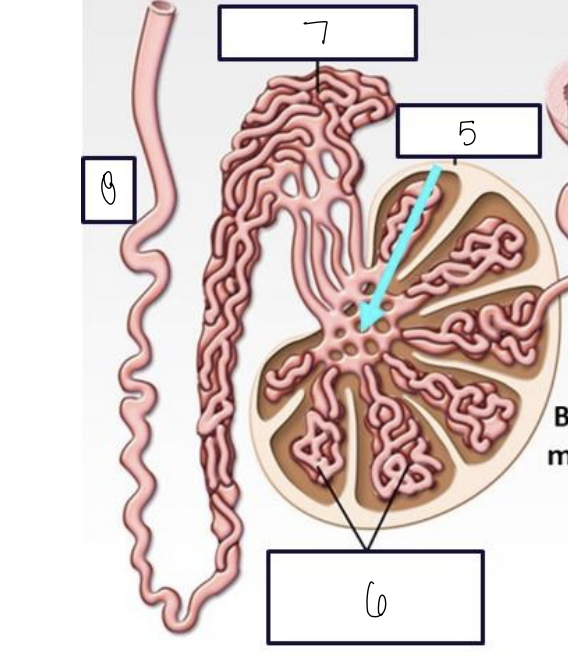
what is 7?
epidiymal head
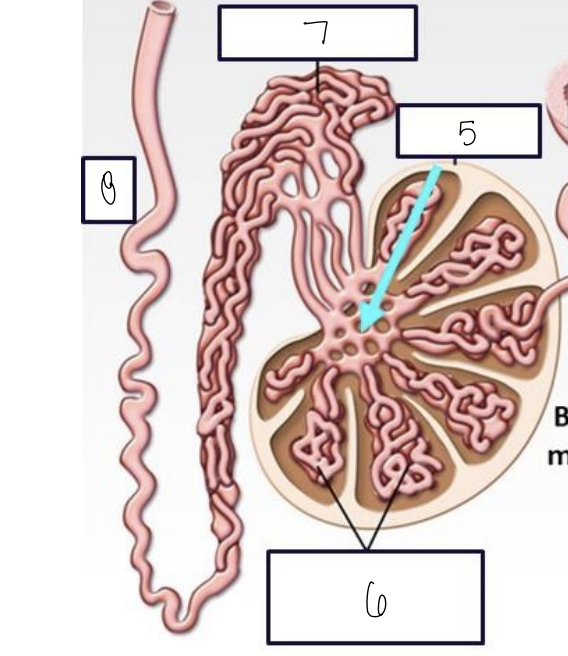
what is 5?
rete testis
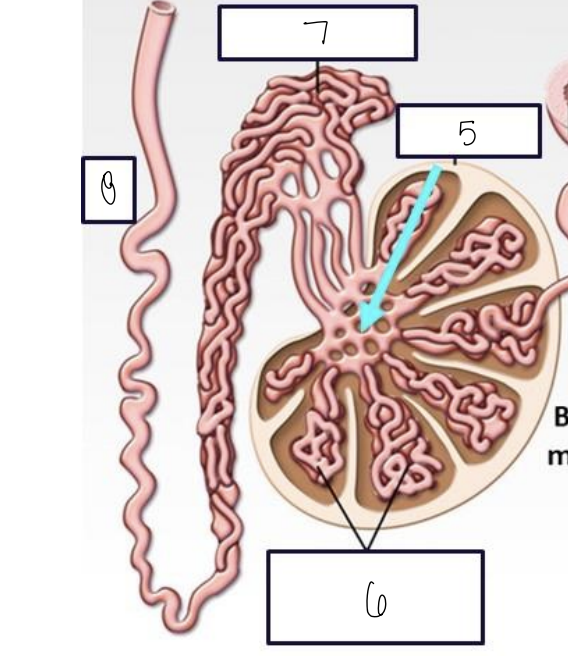
what is 8?
ductus deferens
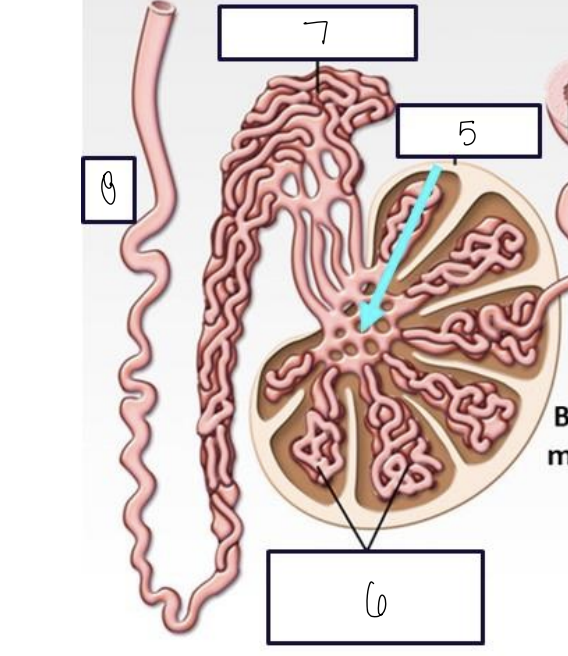
what is 6?
seminiferous tubules
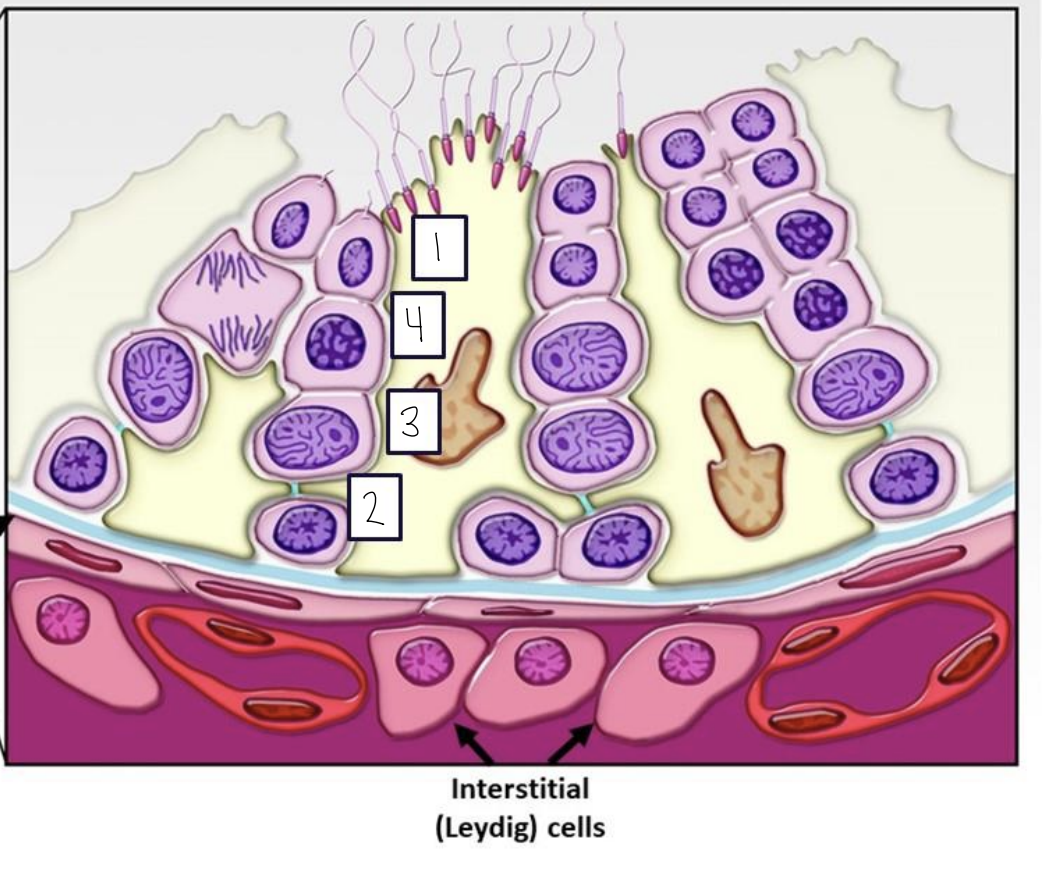
what is 1?
differentiation
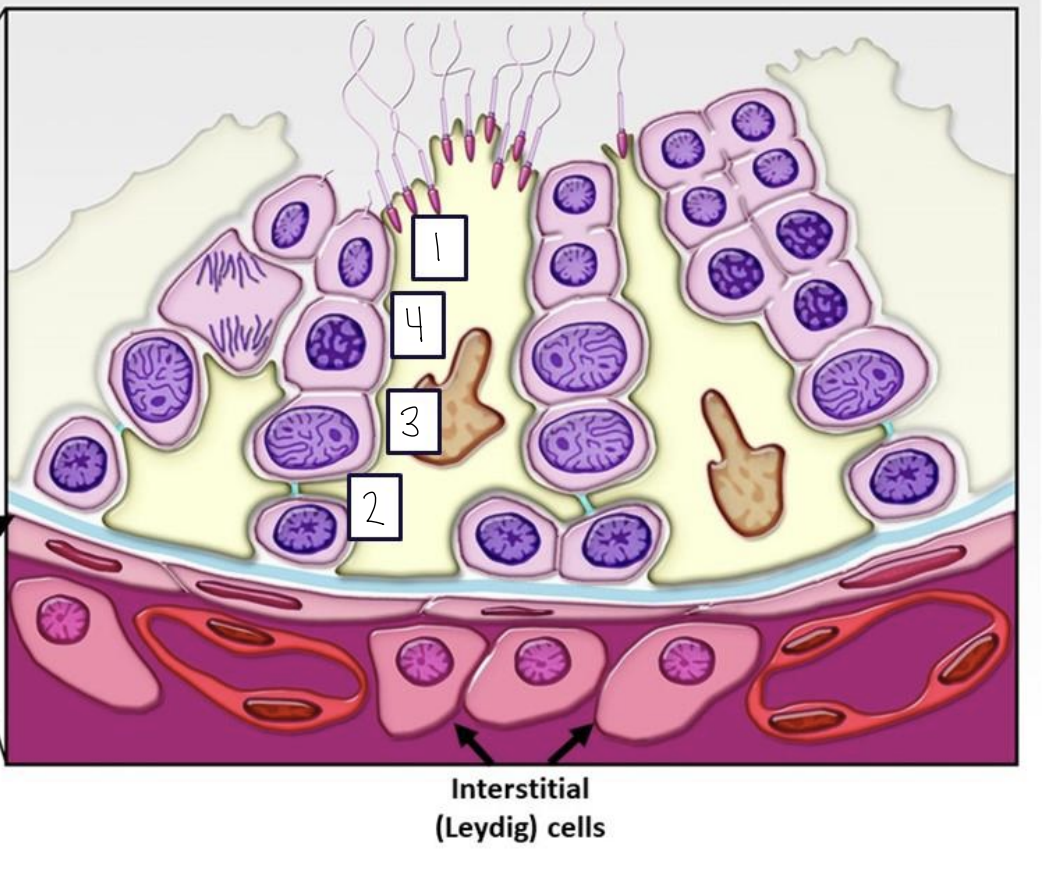
what is 4?
meiosis II
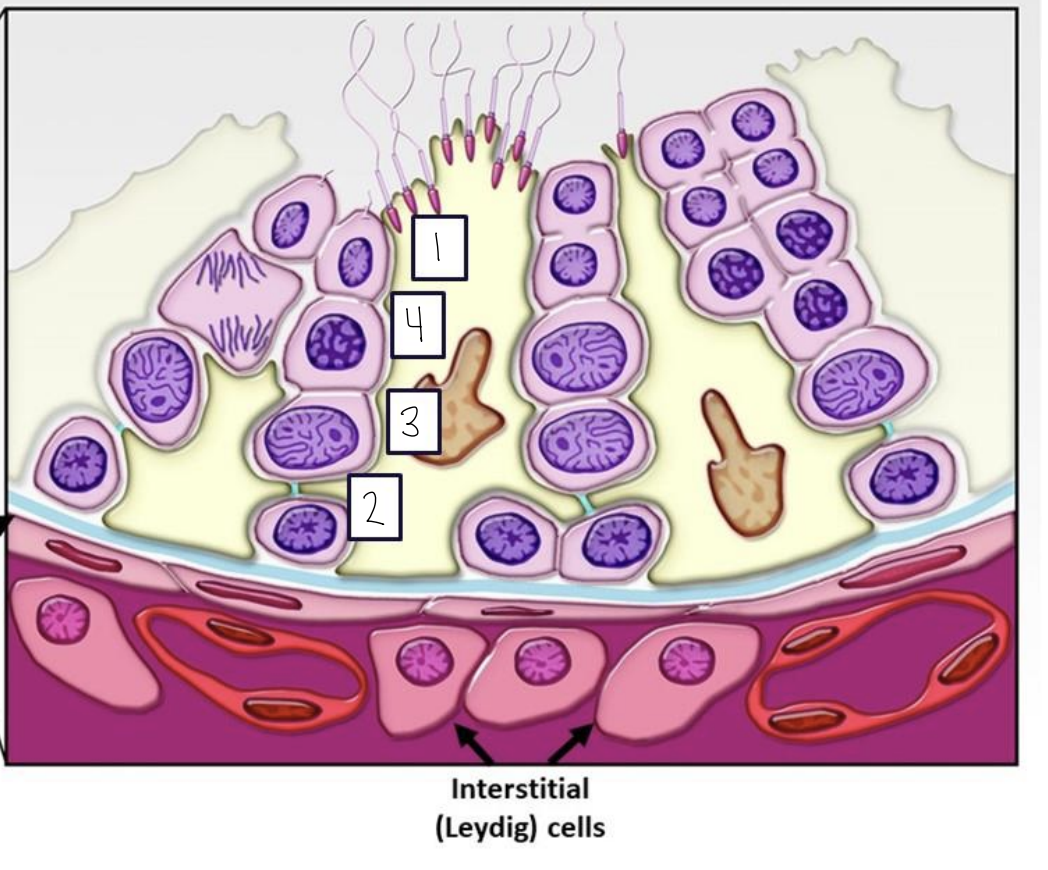
what is 3?
meiosis I
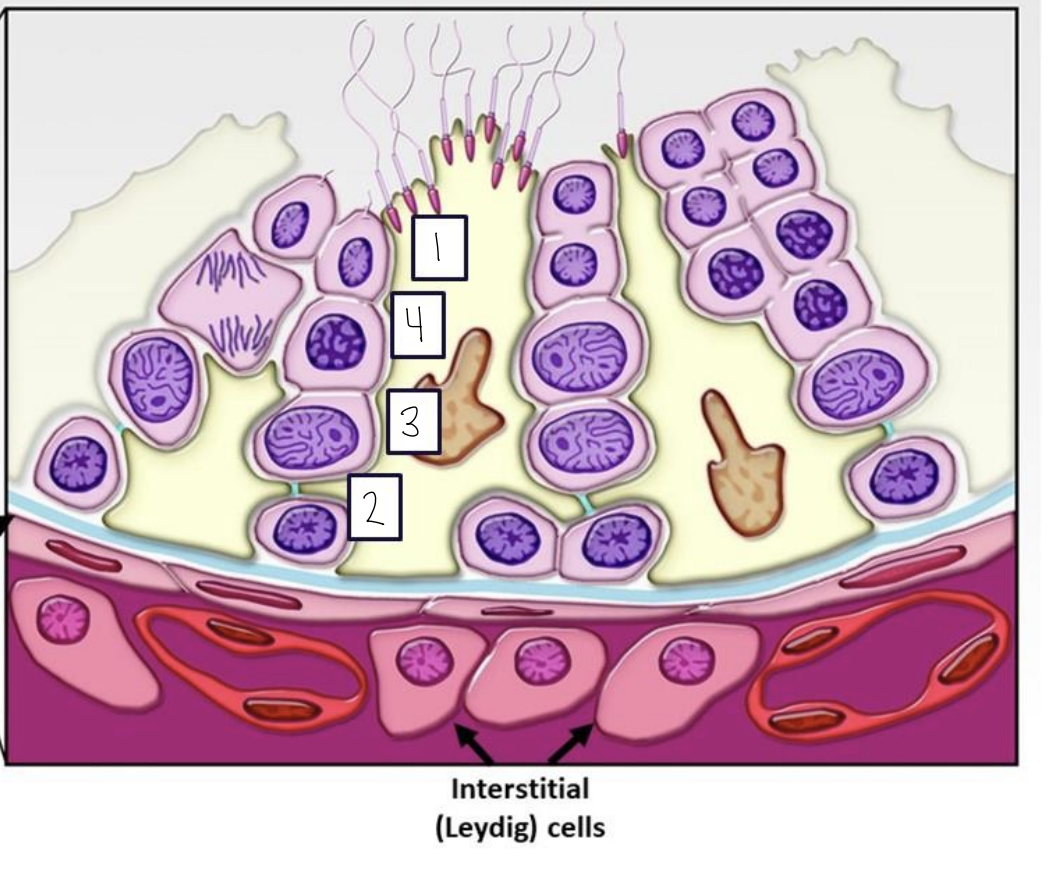
what is 2?
mitosis
tunica albuginias
connective tissue that divides testicles into functional lobules
what is the flow of sperm?
tunica albuginias
convolutes seminiferous tubules
straight seminiferous tubules
rete testes
efferent ductules
head of epidiymis
ductus deferens
seminal vesicles
prostate gland
urethra
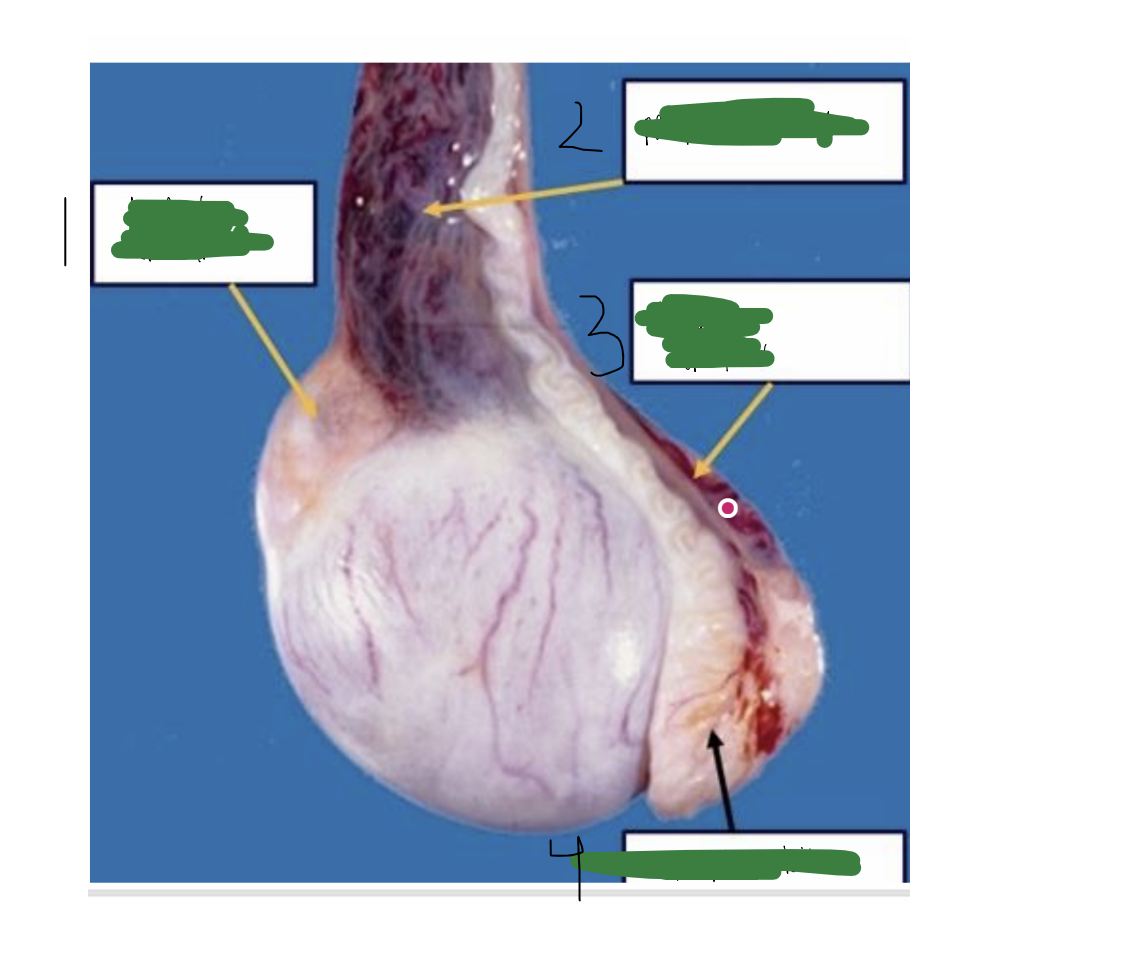
what is 1?
head of epidiymus
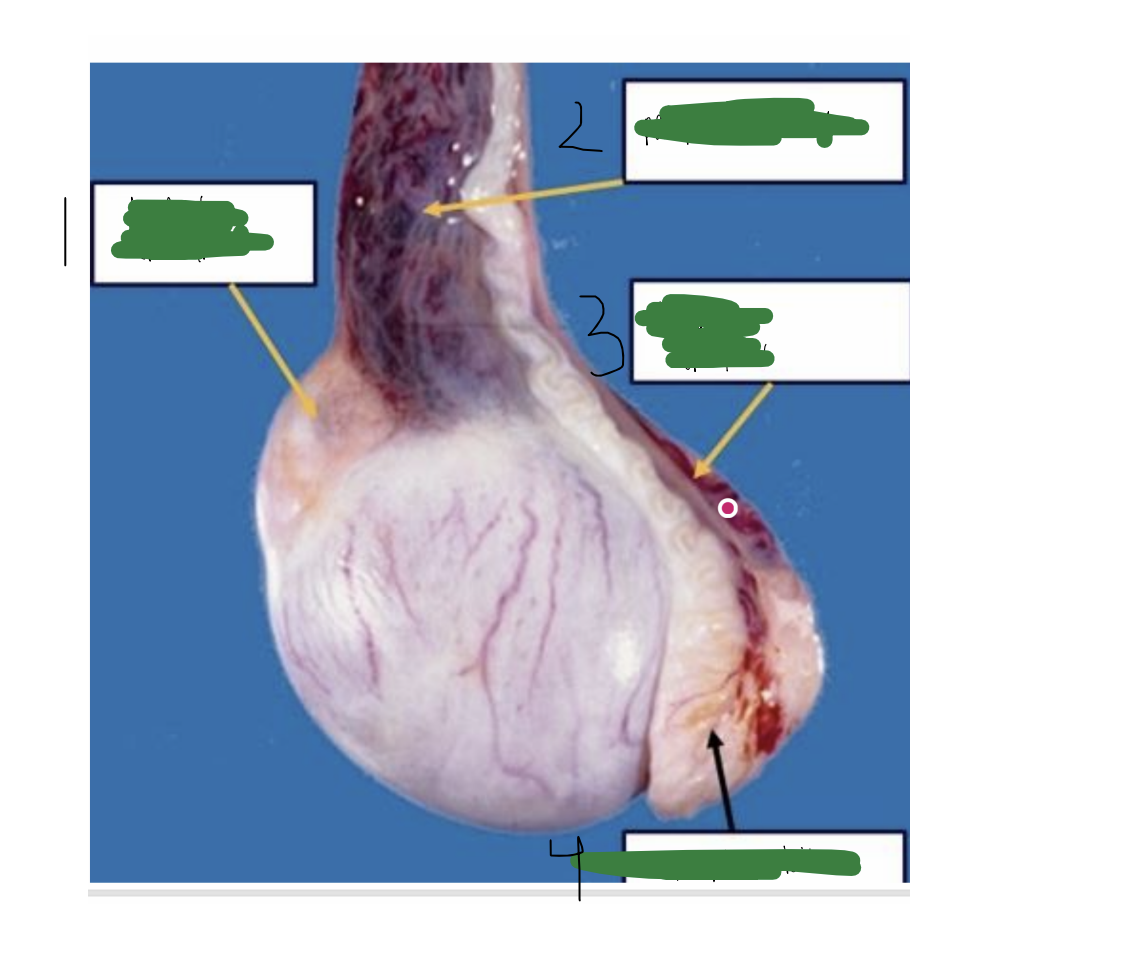
what is 2?
pampiform plexus
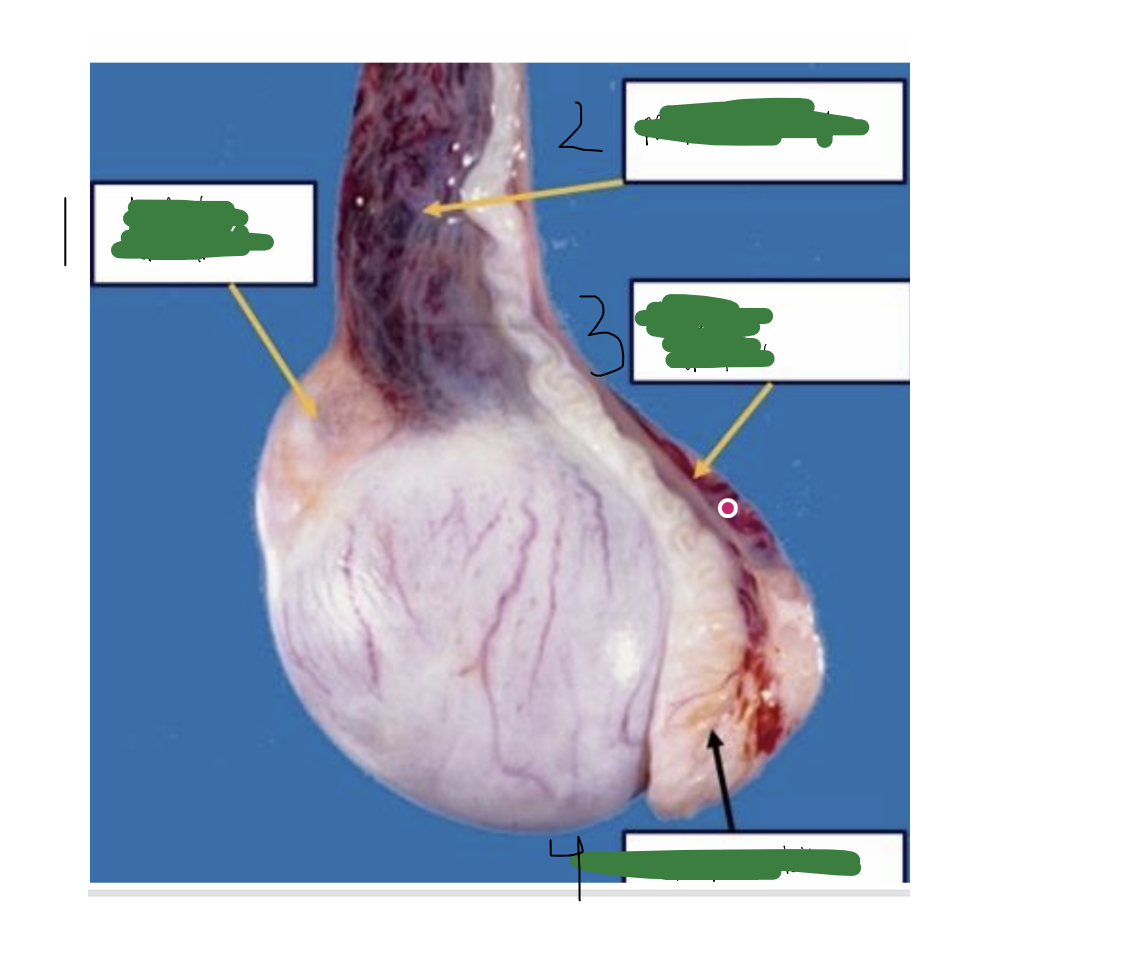
what is 3?
body of epididymis
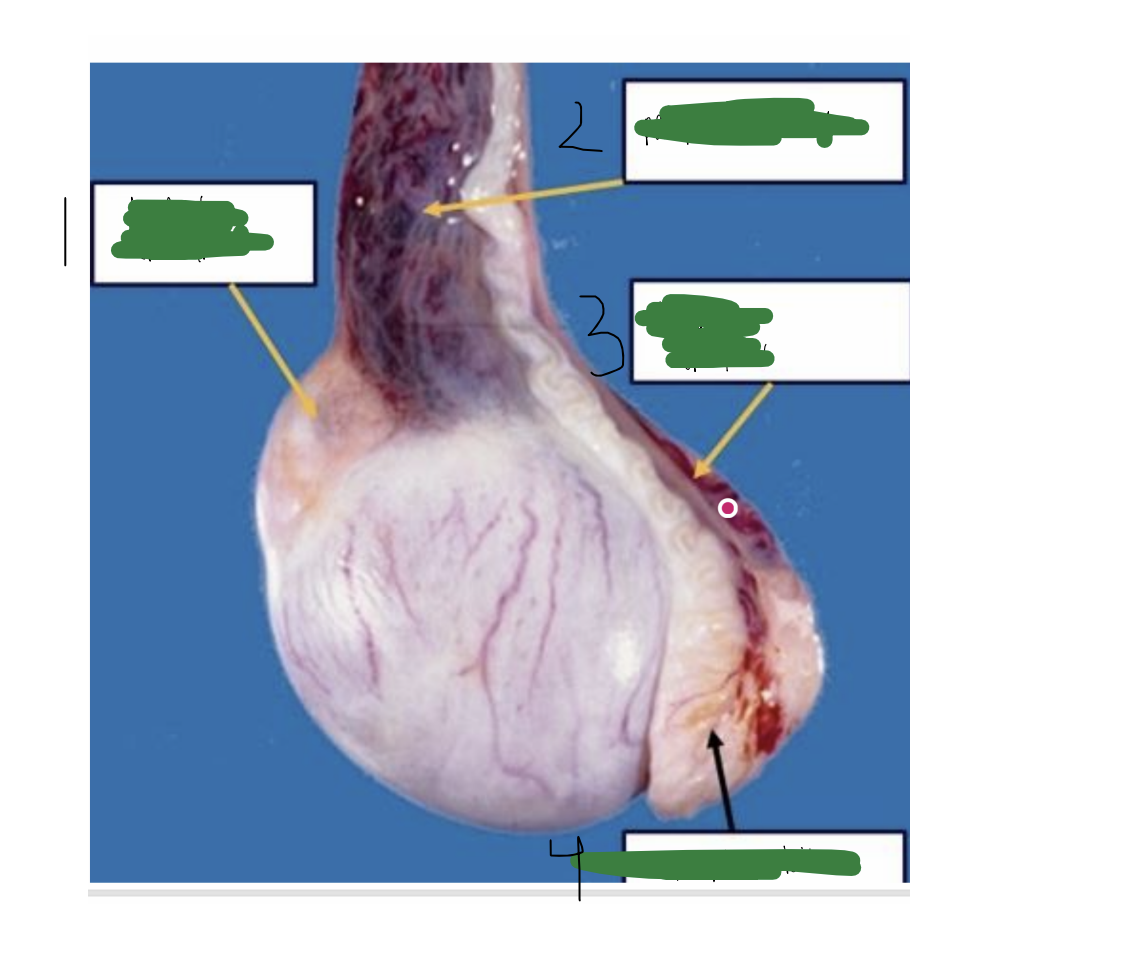
what is 4?
tail of epidiymis
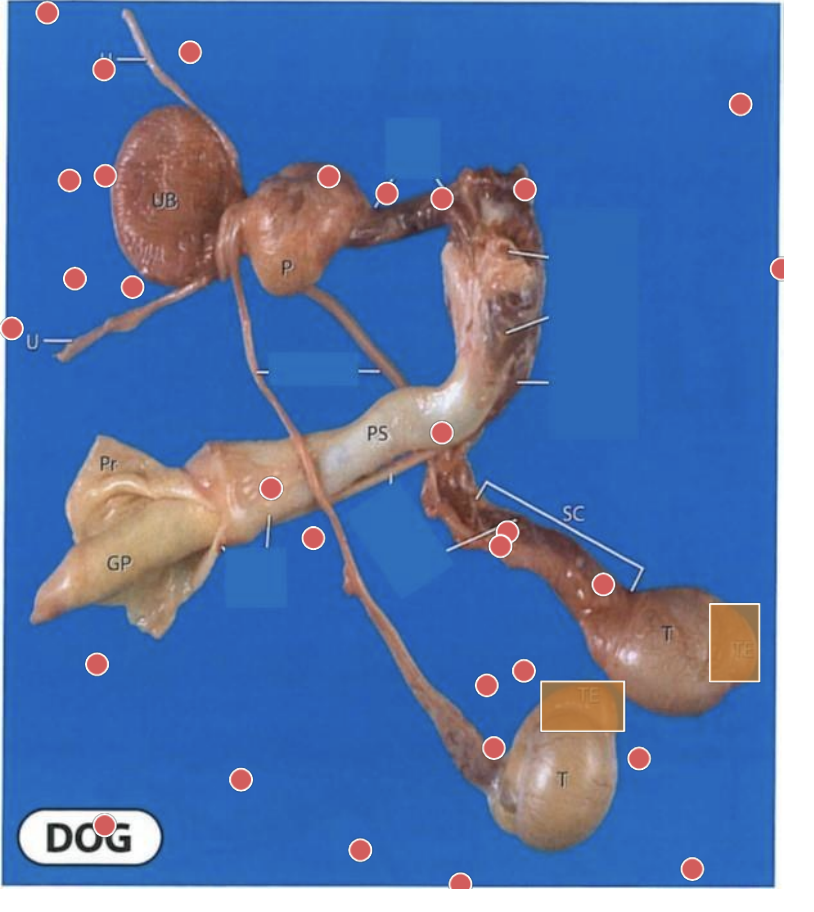
what are the orange boxes indicating?
tail of epididymis
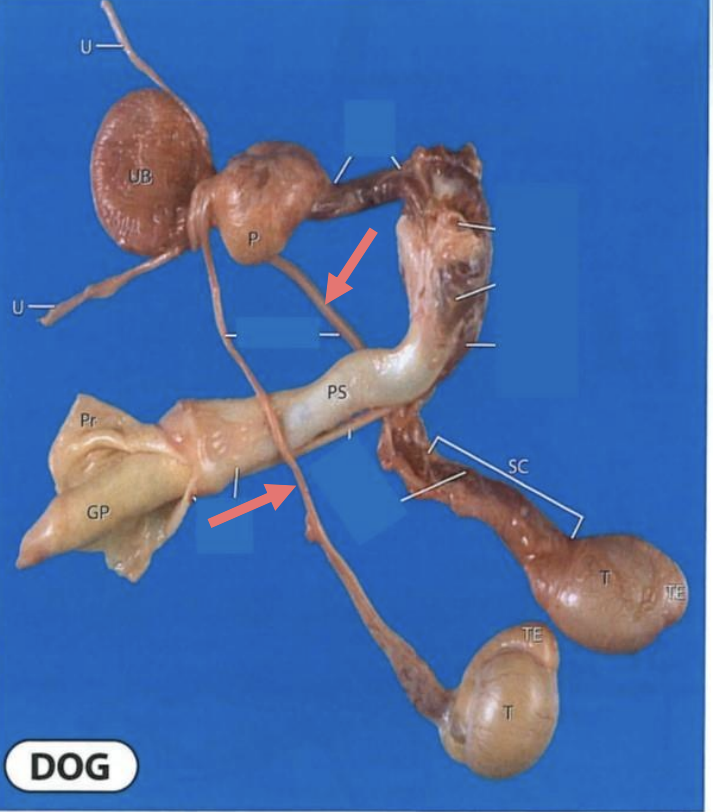
what are the orange arrows pointing at?
ductus deferens